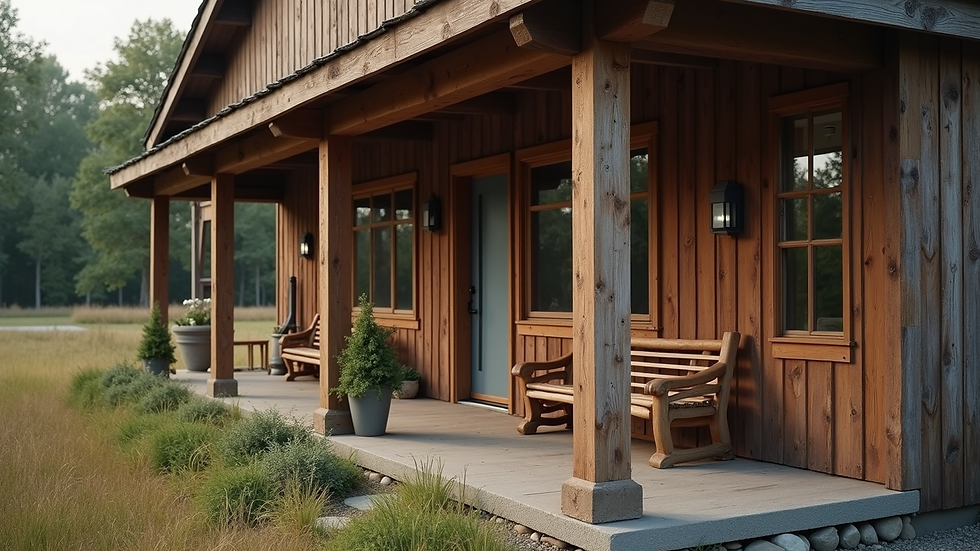A Guide to Choosing the Right Siding for Your Home
- Alex Morgan

- Jul 2
- 4 min read
When it comes to enhancing the curb appeal and protection of your home, choosing the right siding is crucial. Siding not only serves as a protective barrier from the elements but also contributes significantly to your home's aesthetics and value. With a variety of materials, colors, and styles available, selecting the perfect siding for your home can seem overwhelming. This guide will walk you through the key considerations and options to help you make an informed choice.
Understanding Siding: A Siding Guide
Siding is the material attached to the exterior walls of a house. Its primary function is to protect your home from weather conditions such as rain, wind, and snow. Additionally, siding can help insulate your home, improving energy efficiency. The most common siding types include vinyl, wood, fiber-cement, and metal. Each type has its pros and cons, which we will explore in detail to help you determine the best fit for your home.

Different Types of Siding
Vinyl Siding
Vinyl siding is one of the most popular options due to its affordability and low maintenance. It is available in various colors and styles, including traditional clapboard and contemporary vertical boards. Vinyl siding is also resistant to insects, rot, and corrosion, making it a durable choice.
Benefits of vinyl siding:
Affordable initial cost
Low maintenance requirements
Variety of colors and styles
However, if you live in an area prone to extreme temperatures, vinyl siding may warp or crack over time.
Wood Siding
Wood siding offers a classic and timeless look that can enhance the charm of any home. Available in different types, such as cedar and pine, wood can be painted or stained to match your personal style.

Advantages of wood siding:
Attractive natural appearance
Good insulation properties
On the downside, wood siding requires regular maintenance, such as painting or staining, to prevent issues like rot, pests, and weathering.
Fiber-Cement Siding
Fiber-cement siding is a robust and durable option made from a mixture of cement, sand, and cellulose fibers. This type of siding is designed to mimic the look of wood or stucco and is available in a range of styles.
Advantages of fiber-cement siding:
Resistant to pests and fire
Long-lasting lifespan (up to 50 years)
Requires little maintenance
It is heavier than other siding materials, which can increase installation costs. Still, many homeowners find the durability worth the investment.
Metal Siding
Metal siding, typically made from steel or aluminum, is known for its strength and modern appearance. It is resistant to rot, pests, and fire, making it a practical choice for many climates.

Benefits of metal siding:
Long lifespan
Low maintenance
Environmentally friendly option when made from recycled materials
While metal siding is durable, it can be susceptible to dents and may require repainting or refinishing over time.
Factors to Consider When Choosing Siding
Choosing the right siding goes beyond the material itself. Here are some important factors to consider when making your decision:
Climate
Your local climate plays a significant role in determining the best siding for your home. For example, homes in humid areas may benefit from materials resistant to moisture, such as fiber-cement. Conversely, homes in dry climates may choose wood siding for its traditional look.
Maintenance
Consider how much time and money you are willing to spend on maintaining your siding. Vinyl and metal siding often require the least maintenance, while wood siding needs regular upkeep to remain in good condition.
Aesthetic Appeal
Siding can dramatically influence your home’s appearance. It's essential to select a style and color that complements the architectural design of your home and fits within your neighborhood.
Budget
Your budget will also dictate your siding choice. Vinyl siding typically falls on the lower end of the price spectrum, while materials like fiber-cement and wood can be more expensive. Don’t forget to factor in the cost of installation, as professional installation can greatly impact the overall expense.
Installation Considerations
Once you’ve chosen the right siding for your home’s needs, it's crucial to consider the installation process. While some homeowners may attempt a DIY installation, hiring professionals often ensures the best results. If you opt for professional installation, look for siding installation services that offer warranties, quality materials, and skilled labor.
Enhancing Energy Efficiency with Siding
Another significant aspect to consider is how your siding choice can affect energy efficiency. Certain materials can provide better insulation than others, which can lead to lower heating and cooling costs over time.
Tips for improving energy efficiency:
Choose insulated siding panels
Look for energy-efficient materials with good R-values
Consider adding a house wrap before installation to provide an additional layer of insulation
Final Thoughts
Selecting the right siding for your home involves a careful assessment of your aesthetic preferences, local climate, maintenance requirements, and budget. Take the time to research each material thoroughly and evaluate your options to find the best fit for your home’s needs. Whether you go with the low-maintenance traits of vinyl, the classic beauty of wood, the durability of fiber-cement, or the modern touch of metal, the right siding can significantly enhance your home's value and appearance.
Carefully planning your siding choice will ensure that your home remains protected and stylish for years to come. Happy siding shopping!






Comments